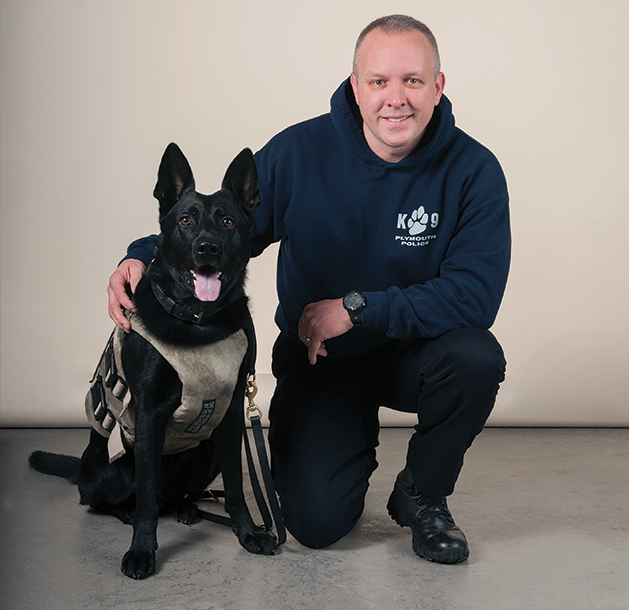
It’s hard to figure out what’s happening from afar, but several police vehicles are at a Plymouth gas station investigating a group of three suspects—they had tried to use a credit card several times there that day. The situation escalates when they find a crack pipe and suspected heroin on a female suspect.
They move to search the SUV and that’s where Plymouth Officer Steve Larson and his K9 partner Knight step in. Knight, a German shepherd, sniffs around the SUV and then goes inside to search in a mess of junk and garbage. He’s able to find drug paraphernalia, but no other drugs. After Knight’s work is done, he patiently waits in the squad SUV while Larson bags the evidence and writes up paperwork.
It’s a busier night for Larson and Knight —they head over to a department store after the gas station where there is a possible shoplifter on the run. Ends up, Knight isn’t needed once they arrive on the scene.
As a K9 unit, the officers are listening for calls where a dog would come in handy. These cases include narcotics, someone fleeing a crime scene, a missing person, evidence recovery or a home break in. They also answer calls in nearby cities that don’t have K9s and for Plymouth’s SWAT team. I rode along with two of the three Plymouth Police K9 Unit teams last fall to find out what it’s like to have a K9 as your partner.
“Our K9 units provide our community an excellent tool to help keep the city safe. Their ability to track and assist in the apprehension of those we are seeking to arrest is exceptional,” says Plymouth Police Chief Michael Goldstein.
Besides the police chief, the K9 unit officers are the only ones who bring home a squad vehicle. The SUVs are outfitted so the dogs have a comfortable place to relax in the back with food and water. Officer Matt Gliniany, whose partner is Stryker, a German shepherd, showed me the supplies they keep in the trunk such as an articles box with objects for fetching, toys, leashes, a first aid kit and a vest for more dangerous situations.
Highly developed skills
Before hitting the streets, the officers and their dogs receive extensive training before patrolling together and continue to train about 16 hours a month to stay sharp. They receive certifications from the United States Police Canine Association as they become a more skilled team.
Gliniany explains that there are different levels of Police Dog (PD) certifications. PDI certification involves obedience, agility, person search, article search and apprehension. For PDII, the dog navigates an unknown track laid by another person. PDIIX is an expert certification. Narcotics certification consists of indoor and outdoor searches for substances such as marijuana, methamphetamine, cocaine, crack and heroin.
Larson and Knight, and Officer Bill Dane paired with K9 Odie, a Belgian Malinois, are certified in PDI, PDII and narcotics detection. Gliniany and Stryker are at the expert level along with narcotics.
Another aspect of work involves apprehension. If needed, the dogs are trained to bite and hold a suspect. This helps the officers get a suspect safely into custody.
“They’re easy to train, loyal and they adapt well to the stress,” says Gliniany. The officers make the training more enjoyable by teaching skills using games and rewards. “We show what we want and praise them when they do it well.”
A Powerful Nose
Scent-tracking dogs demonstrate their capabilities by routinely accomplishing remarkable feats in unfamiliar environments and on the trail of unfamiliar people such as missing persons or suspects on the run. They can also quickly retrieve an object like a knife or gun. During the ride along, Gliniany stopped by a tall grassy field at dusk for a quick demonstration.
I rubbed my hands all over a screw driver and he did the same with a wallet before we threw them out into the field. Once Stryker was given the command “fetch,” he swiftly scoped out the perimeter meticulously back and forth. Within moments, Gliniany had both objects in front him.
Gliniany explained that he would say “seek dope” to alert Stryker to search for narcotics. OnceStryker entered an apartment building to find a unit selling drugs. He easily identified the unit by sniffing outside 15 doors from the hallway.
How do dogs like Stryker have such a great sense of smell? They possess up to 300 million olfactory receptors in their noses compared to about 6 million in humans. Plus, the part of their brain that is devoted to analyzing smells is, proportionally speaking, 40 times greater than humans, scientists report.
People tend to think they can cover their tracks, but you’re always leaving behind a scent, Gliniany says.
“Dogs smell in layers,” he continues. For instance, humans simply smell the aroma of chicken soup. A dog could separate the components out such as the chicken, carrots and celery.
When prompted for an example, Larson says Knight successfully located a suspect who was later charged with attempting to sexually assault a young girl while staying as a guest at an Airbnb home in a neighboring suburb. The man fled the scene on foot and Knight found him hidden outside a nearby house.
“Without a dog, you couldn’t do any of that,” Gliniany says.
At Work and Home
The police K9s usually live with their handlers, which is an incredible privilege and responsibility. “It’s a positive experience. We put in a lot of time and effort into what we do. No matter how docile he is, we can’t have anyone take care of him or take him out,” Larson says.
Larson has worked together with Knight since 2013 and Stryker became Gliniany’s partner in 2009. Police dogs usually begin work when they’re about a year old.
“He likes to go to work,” says Gliniany. “He’ll even go sit by the squad car sometimes … I always joke around that ‘A bad day at work is better than a good day at home’ for Stryker.’”
As I experienced, Stryker and Knight are intimidating on the job—the barking is intense. Once given an introduction though, I was able to pet them.
Both officers note a distinct change in personalities at home and work. “When Stryker gets home from a shift, he just gets out and lays down. He’s much more laid back at home. He’s more engaged, tuned in when he’s at work,” Gliniany says.
Larson describes Knight as “mellow” at home. He even lets the younger dog at home, Hula, have her way. “She steals his bones and he just walks away from her,” he says.
During the ride alongs, Gliniany and Larson also described the special bond they share with their K9s. Larson says they don’t have to work as hard in training as they spend more time together.
“We work off each other. We can read each other’s nonverbal cues. We’re much more comfortable and confident now than when we first started,” Larson says. “I spend more time with him than my wife.”
Gliniany says Stryker is always studying his mannerisms and can often anticipate what he will do in certain situations especially during training. “You’ve always got your best friend with you,” he says.
Out In the Community
“The community outreach activities our K9 Units participate in allow us to better engage with the public; whereby stronger partnerships with the greater community have been achieved,” says Goldstein.
Larson says the unit has given demonstrations at Cub Scout meetings, DARE graduations and retirement communities. The K9 unit is often out at city events, including National Night Out and Music in Plymouth.
When you see a police dog, Gliniany advises it’s important to ask if the dog is working. Also, don’t break out in a run because the dog won’t know if you’re a bad guy or planning on attacking him.
K9s need first aid, too
Behind the scenes, Northwest Animal Hospital has provided care and medications for Plymouth Police’s K9 Unit at a heavily discounted price since 2012.
“It makes a difference in our community to have these dogs working. They help to keep us safe. The dogs are so highly trained and so valuable,” says Sara M. Williams, DVM, MPH, CVA, owner of Northwest Animal Hospital.
When Williams and Gliniany realized that K9 officers didn’t receive any training on what to do when their K9 partners were injured, they developed a two-hour first aid course and a medical kit in 2014. Since then, more than 40 officers including Plymouth, State Patrol, Metro Transit, St. Cloud, Mall of America and Minneapolis have been trained and equipped. Molly McGinnis, CVT, from Northwest has also been teaching due to the demand.
“There isn’t anyone doing it in the country right now,” she says, hoping to expand the program nationally.
The training has come in handy. A couple of years ago, Odie overheated during training on a hot day—reaching an alarmingly high temperature of 108 when a normal temperature is around 102. They immediately applied cold compresses to Odie on the way to seeking medical care which most likely saved his life, Gliniany says.
“It’s nice to be able to fill this void. There’s definitely a need. It’s really rewarding that they’ve been using the information,” Williams says.









